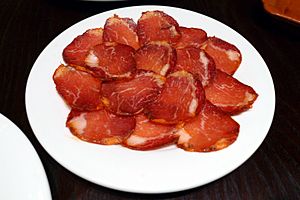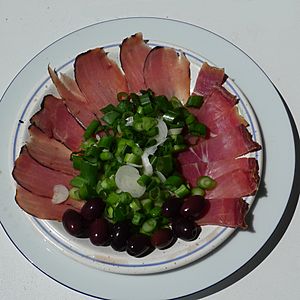Cured pork tenderloin facts for kids

Spanish “lomo”
|
|
| Main ingredients | Pork |
|---|---|
Cured pork tenderloin is a special kind of meat found in many countries. You'll find it in places around the Mediterranean Sea in Europe and also in South America.
This meat is usually prepared by adding salt or soaking it in a salty water mix called brine. After that, it's either left to dry and cure, or it's smoked. This process helps to preserve the meat and gives it a unique flavor.
Contents
Cured Pork in Different Countries
Spain
In Spanish cuisine, cured pork tenderloin is called lomo embuchado. Sometimes it's also known as caña de lomo or just lomo. It's a dry-cured meat made from pork tenderloin. It's a bit like cecina, but cecina is made from beef.
Italy
In Italian cuisine, there are many types of cured pork tenderloin. One similar meat is Capocollo, but that's made from the neck muscle, not the tenderloin. In the area near Trieste and in parts of Slovenia and Croatia, this cured meat is also called ombolo.
Corsica
In Corsican cuisine, the cured loin is known as lonzu.
Cyprus
In Cypriot cuisine, the cured pork tenderloin is called lountza (Greek: λούντζα). First, the pork tenderloin is soaked in a salty water mix and then in red wine. After that, it's dried and smoked.
Lountza can be eaten right after it's smoked, or it can be aged. When it gets older, it becomes harder and has a stronger taste. Sometimes, people add coriander spice to it.
You can eat lountza cooked or uncooked. People often enjoy it with alcoholic drinks like zivania or wine. Grilled lountza is often served with other Cypriot foods like halloumi and kefalotyri cheese on meze platters. Sandwiches with grilled lountza and halloumi are popular fast food snacks in Cyprus.
Greece
In the northern Cyclades islands of Greece, like Mykonos and Syros, a preserved pork loin is called louza.
Southeastern Europe
In countries like Bosnia and Herzegovina, Croatia, Montenegro, and Serbia, smoked and cured loins are called pečenica (meaning "that which is baked") or vješalica (meaning "that which is hung"). They are usually made from pork, but beef versions are also common.
These meats are typically made during the winter and are considered a traditional winter food. The curing process involves soaking the meat in a salty water mix with garlic. Then, they are hung in the cold winter air and smoked over wood for up to two months. The freezing temperatures and lack of insects in winter help the meat to cure and stay fresh.
The flavor of these meats is very smoky and has a strong garlic taste. They are usually dryer and harder than other cured meats. People often eat them as cold cuts, as part of a traditional meze platter, or use them to add flavor to cooked dishes.
Bulgaria
In Bulgaria, the cured pork loin is known as "Filet Elena" (Филе Елена).
Where the Name Comes From
Most of the names for this cured meat, like lomo or lonza, come from the Latin language word lumbus, which means 'loin'. However, the names used in the Balkan region, like pečenica, describe how the meat is actually prepared.
Lomo de cerdo



